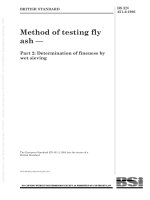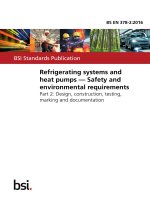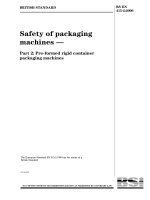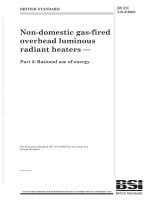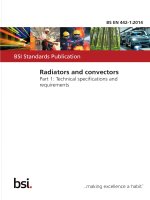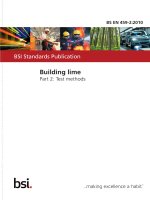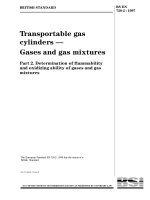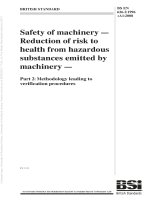Bsi bs en 01514 2 2014
Bạn đang xem bản rút gọn của tài liệu. Xem và tải ngay bản đầy đủ của tài liệu tại đây (1.05 MB, 20 trang )
BS EN 1514-2:2014
BSI Standards Publication
Flanges and their joints —
Gaskets for PN-designated
flanges
Part 2: Spiral wound gaskets for use with
steel flanges
BS EN 1514-2:2014
BRITISH STANDARD
National foreword
This British Standard is the UK implementation of EN 1514-2:2014. It
supersedes BS EN 1514-2:2005 which is withdrawn.
The UK participation in its preparation was entrusted to Technical
Committee PSE/15/2, Flanges - Jointing materials and compounds.
A list of organizations represented on this committee can be
obtained on request to its secretary.
This publication does not purport to include all the necessary
provisions of a contract. Users are responsible for its correct
application.
© The British Standards Institution 2014. Published by BSI Standards
Limited 2014
ISBN 978 0 580 77211 5
ICS 23.040.80
Compliance with a British Standard cannot confer immunity from
legal obligations.
This British Standard was published under the authority of the
Standards Policy and Strategy Committee on 30 September 2014.
Amendments issued since publication
Date
Text affected
BS EN 1514-2:2014
EN 1514-2
EUROPEAN STANDARD
NORME EUROPÉENNE
EUROPÄISCHE NORM
September 2014
ICS 23.040.80
Supersedes EN 1514-2:2005
English Version
Flanges and their joints - Gaskets for PN-designated flanges Part 2: Spiral wound gaskets for use with steel flanges
Brides et leurs assemblages - Joints pour les brides
désignées PN - Partie 2 : Joints spiralés pour utilisation
avec des brides en acier
Flansche und ihre Verbindungen - Dichtungen für Flansche
mit PN-Bezeichnung - Teil 2: Spiraldichtungen für
Stahlflansche
This European Standard was approved by CEN on 25 July 2014.
CEN members are bound to comply with the CEN/CENELEC Internal Regulations which stipulate the conditions for giving this European
Standard the status of a national standard without any alteration. Up-to-date lists and bibliographical references concerning such national
standards may be obtained on application to the CEN-CENELEC Management Centre or to any CEN member.
This European Standard exists in three official versions (English, French, German). A version in any other language made by translation
under the responsibility of a CEN member into its own language and notified to the CEN-CENELEC Management Centre has the same
status as the official versions.
CEN members are the national standards bodies of Austria, Belgium, Bulgaria, Croatia, Cyprus, Czech Republic, Denmark, Estonia,
Finland, Former Yugoslav Republic of Macedonia, France, Germany, Greece, Hungary, Iceland, Ireland, Italy, Latvia, Lithuania,
Luxembourg, Malta, Netherlands, Norway, Poland, Portugal, Romania, Slovakia, Slovenia, Spain, Sweden, Switzerland, Turkey and United
Kingdom.
EUROPEAN COMMITTEE FOR STANDARDIZATION
COMITÉ EUROPÉEN DE NORMALISATION
EUROPÄISCHES KOMITEE FÜR NORMUNG
CEN-CENELEC Management Centre: Avenue Marnix 17, B-1000 Brussels
© 2014 CEN
All rights of exploitation in any form and by any means reserved
worldwide for CEN national Members.
Ref. No. EN 1514-2:2014 E
BS EN 1514-2:2014
EN 1514-2:2014 (E)
Contents
Page
Foreword ..............................................................................................................................................................3
Introduction .........................................................................................................................................................4
1
Scope ......................................................................................................................................................5
2
Normative references ............................................................................................................................5
3
Terms and definitions ...........................................................................................................................5
4
4.1
4.1.1
4.1.2
4.1.3
4.2
4.3
4.4
4.5
Designations ..........................................................................................................................................6
Essential features and dimensions......................................................................................................6
General ....................................................................................................................................................6
Maximum compression .........................................................................................................................7
Use of an inner ring ...............................................................................................................................7
Range of PN designations ....................................................................................................................7
Range of DN (nominal sizes) ................................................................................................................8
Gasket types...........................................................................................................................................8
Information to be supplied by the purchaser .....................................................................................8
5
Gasket designs ......................................................................................................................................8
6
Gasket types...........................................................................................................................................9
7
Dimensions .............................................................................................................................................9
8
8.1
8.2
Marking ................................................................................................................................................ 13
General ................................................................................................................................................. 13
Colour coding ...................................................................................................................................... 13
Annex A (informative) Information to be supplied by the purchaser ........................................................ 15
Bibliography ..................................................................................................................................................... 16
2
BS EN 1514-2:2014
EN 1514-2:2014 (E)
Foreword
This document (EN 1514-2:2014) has been prepared by Technical Committee CEN/TC 74 “Flanges and their
joints”, the secretariat of which is held by DIN.
This European Standard shall be given the status of a national standard, either by publication of an identical
text or by endorsement, at the latest by March 2015, and conflicting national standards shall be withdrawn at
the latest by March 2015.
Attention is drawn to the possibility that some of the elements of this document may be the subject of patent
rights. CEN [and/or CENELEC] shall not be held responsible for identifying any or all such patent rights.
This document supersedes EN 1514-2:2005.
The reason for the revision is to include dimensions for PN 16. The dimensions of the various components of
the spiral wound gaskets described and their tolerances have been set with the objective of controlling the
possibility of protrusion of the inner ring into the bore of the pipeline being sealed. The other features of this
European Standard have been set in order to ensure good functionality of spiral wound gaskets made
according to this European Standard.
EN 1514, Flanges and their joints — (Dimensions of) gaskets for PN-designated flanges, consists of the
following parts:
—
Part 1: Non-metallic flat gaskets with or without inserts;
—
Part 2: Spiral wound gaskets for use with steel flanges;
—
Part 3: Non-metallic PTFE envelope gaskets;
—
Part 4: Corrugated, flat or grooved metallic and filled metallic gaskets for use with steel flanges;
—
Part 6: Covered serrated metal gaskets for use with steel flanges;
—
Part 7: Covered metal jacketed gaskets for use with steel flanges;
—
Part 8: Polymeric O-Ring gaskets for grooved flanges.
According to the CEN-CENELEC Internal Regulations, the national standards organizations of the following
countries are bound to implement this European Standard: Austria, Belgium, Bulgaria, Croatia, Cyprus, Czech
Republic, Denmark, Estonia, Finland, Former Yugoslav Republic of Macedonia, France, Germany, Greece,
Hungary, Iceland, Ireland, Italy, Latvia, Lithuania, Luxembourg, Malta, Netherlands, Norway, Poland, Portugal,
Romania, Slovakia, Slovenia, Spain, Sweden, Switzerland, Turkey and the United Kingdom.
3
BS EN 1514-2:2014
EN 1514-2:2014 (E)
Introduction
The dimensions of spiral wound gaskets for tongue and groove flanges and spigot and recess flanges to
EN 1092-1 are not included in this part of EN 1514. Such gaskets may be available for these types of flange
and the purchaser is advised to consult the manufacturer as to their availability.
4
BS EN 1514-2:2014
EN 1514-2:2014 (E)
1
Scope
This part of EN 1514 specifies the dimensions and marking of spiral wound gaskets for use in conjunction with
flat face and raised face flanges complying with the requirements of EN 1092-1 for PN 10, PN 16, PN 25,
PN 40, PN 63, PN 100 and PN 160 and up to and including DN 1 000.
NOTE 1
Dimensions of other types of gaskets for use with flanges to EN 1092-1, EN 1092-2, EN 1092-3 and
EN 1092-4 are given in EN 1514-1, EN 1514-3, EN 1514-4, EN 1514-6, EN 1514-7 and EN 1514-8.
NOTE 2
Annex A lists information to be supplied by the purchaser when ordering gaskets in circumstances where the
choice of the gasket materials appropriate to the service is left to the manufacturer.
2
Normative references
The following documents, in whole or in part, are normatively referenced in this document and are
indispensable for its application. For dated references, only the edition cited applies. For undated references,
the latest edition of the referenced document (including any amendments) applies.
EN 1333, Flanges and their joints - Pipework components - Definition and selection of PN
EN ISO 6708, Pipework components - Definition and selection of DN (nominal size) (ISO 6708)
3
Terms and definitions
For the purposes of this document, the following terms and definitions apply.
3.1
DN
alphanumeric designation of size for components of a pipework system, which is used for reference purposes.
It comprises the letters DN followed by a dimensionless whole number which is indirectly related to the
physical size, in millimetres, of the bore or outside diameter of the end connections
Note 1 to entry:
The number following the letters DN does not represent a measurable value and should not be used
for calculation purposes except where specified in the relevant standard.
Note 2 to entry:
In those standards which use the DN designation system, any relationship between DN and
component dimensions should be given (e.g. DN/OD or DN/ID).
Note 3 to entry:
The preferred DN values are:
DN 10
DN 250
DN 1 500
DN 15
DN 300
DN 1 600
DN 20
DN 350
DN 1 800
DN 25
DN 400
DN 2 000
DN 32
DN 450
DN 2 200
DN 40
DN 500
DN 2 400
DN 50
DN 600
DN 2 600
DN 60
DN 700
DN 2 800
DN 65
DN 800
DN 3 000
DN 80
DN 900
DN 3 200
5
BS EN 1514-2:2014
EN 1514-2:2014 (E)
DN 100
DN 1 000
DN 3 400
DN 125
DN 1 100
DN 3 600
DN 150
DN 1 200
DN 3 800
DN 200
DN 1 400
DN 4 000
[SOURCE: EN ISO 6708:1995, 2.1 and Clause 3]
3.2
PN
alphanumeric designation used for reference purposes related to a combination of mechanical and
dimensional characteristics of a component of a pipework system. It comprises the letters PN followed by a
dimensionless number
Note 1 to entry:
The number following the letters PN does not represent a measurable value and should not be used
for calculation purposes except where specified in the relevant standard.
Note 2 to entry:
The designation PN is not meaningful unless it is related to the relevant component standard number.
Note 3 to entry:
The maximum allowable pressure of a pipework component depends on the PN number, the material
and design of the component, its maximum allowable temperature, etc. The relevant European Component standards
include tables of specified pressure/temperature ratings or, in minimum, include rules how to determine
pressure/temperature ratings.
Note 4 to entry:
It is intended that all components with the same PN and DN designations have the same mating
dimensions for compatible flange types.
Note 5 to entry:
The preferred PN values are:
PN 2,5
PN 25
PN 160
PN 6
PN 40
PN 250
PN 10
PN 63
PN 320
PN 16
PN 100
PN 400
[SOURCE: EN 1333:2006, 2.1 and Clause 3]
4
Designations
4.1 Essential features and dimensions
4.1.1
General
A major feature of the design of spiral wound gaskets meeting the requirements of this European Standard is
the minimisation of the possibility of the inner ring protruding into the bore of the pipe to which the flange is
attached. The fit of the inner ring and sealing element relative to the centring ring has been selected to comply
with this requirement.
The essential features of a spiral wound gasket that complies with the requirements of this European
Standard are given in Figures 1 and 2 and/or are shown in Table 1.
6
BS EN 1514-2:2014
EN 1514-2:2014 (E)
Table 1 — Spiral wound gaskets - Essential features
Parameter
Movement of centre of inner ring relative to centring ring
Feature
up to DN 200 : a maximum of 0,2 mm
above DN 200 : a maximum of 0,4 mm
Centring ring thickness
3 mm ± 0,25 mm
Sealing element location groove shall be centrally located
in the centring ring
centre ± 0,1 mm
Number of empty wraps on external diameter of the sealing
element
3 to 5
Number of empty wraps on the internal diameter of the
sealing element
2 to 3
Number of welds on the inner and outer diameters of the
sealing element, i.e. on the empty wraps
Minimum of 4
Thickness of the metal of the sealing element
0,2 mm ± 0,02 mm
Width of the profiled metal of the sealing element
4,5 mm + 00.3 mm
Thickness of the filler material
As appropriate for the filler type
Protrusion of the filler above the profiled metal of the
sealing element
0,3 mm ± 0,1 mm
Compression of the sealing element
Shall not result in contact between the flange
and the centring ring (also see 4.1.2)
Graphite ash content
2 % maximum by weight
PTFE filler
May be either sintered or un-sintered
Sharp edges on inner and centring ring
Shall be removed
Dimensions
Shall be as given in Table 2
4.1.2
Maximum compression
Metal to metal contact between the centring ring and the flange shall not be achieved with the maximum load
that can be generated by the flange bolts.
4.1.3
Use of an inner ring
An inner ring shall be used with all gaskets using PTFE as the filler and with all gaskets for pressure groups
PN 63, PN 100 and PN 160.
In addition, it is strongly recommended that an inner ring should be used with all gaskets, this should be
specified on the order for all gaskets for pressure groups PN 10, PN 16, PN 25 and PN 40.
4.2 Range of PN designations
Gaskets shall be designated as suitable for use with one or more of these PN flange designations:
a)
PN 10;
b)
PN 16;
c)
PN 25;
7
BS EN 1514-2:2014
EN 1514-2:2014 (E)
d)
PN 40;
e)
PN 63;
f)
PN 100;
g)
PN 160.
4.3 Range of DN (nominal sizes)
Gasket nominal sizes shall be designated in accordance with the ranges specified in Table 2.
4.4 Gasket types
Gasket types are shown in Clause 6 and illustrated in Figure 1.
4.5 Information to be supplied by the purchaser
Where the purchaser requires the manufacturer to specify the materials of the gasket, then the minimum
information that shall be supplied to the manufacturer with the order is given in Annex A.
5
Gasket designs
Gaskets for which dimensions are specified shall be of one of the designs shown in Figure 1.
The clearance between the sealing element and the centring ring shall be as shown in Figure 2.
NOTE 1
Figure 1 shows a typical design of a metallic spiral wound gasket and, for use with type A or type B flanges.
NOTE 2
Type A and type B flange facings are illustrated in EN 1092-1.
NOTE 3
The profile of the metal winding of the sealing element is at the option of the manufacturer.
The materials of the gasket may be specified either by:
a)
the purchaser; or
b)
if required by the purchaser, by the manufacturer to suit the application operating conditions. In this case,
the purchaser shall define the operating conditions in the enquiry and/or order (see Annex A).
The attention of the user is drawn to the load necessary to compress spiral wound gaskets and the available
load with PN 10 flanges should be verified as adequate prior to using these gaskets.
8
BS EN 1514-2:2014
EN 1514-2:2014 (E)
a)
Type C/I
b)
Type C/O
Figure 1 — Spiral wound gaskets
6
Gasket types
Gaskets shall be either:
a)
Type C/I having a sealing element with centring ring and inner ring; or
b)
Type C/O having a sealing element with centring ring.
All gaskets shall have a centring ring.
All PN 63, PN 100 and PN 160 gaskets shall have an inner ring.
All gaskets containing PTFE filler material shall have an inner ring.
The use of an inner ring is recommended for all PN designations and the purchaser shall specify on the
enquiry and/or order if an inner ring is required for PN 10, PN 16, PN 25 and PN 40 gaskets (see Annex A).
The selection of gasket type should take into account the fluids, the operating conditions, the properties of the
gasket materials, the type and surface finish of the flange facing and the flange bolt loading. It is
recommended that selection of gaskets for any particular application is made in consultation with the gasket
supplier (see Annex A).
7
Dimensions
The dimensions of spiral wound gaskets for Types A and B flange facings shall be as given in Table 2 and the
overall thickness, including filler, shall be as given in Figure 2.
9
BS EN 1514-2:2014
EN 1514-2:2014 (E)
Dimensions in millimetres
Key
1
2 to 3 empty wraps
5
Minimum of four welding points for each
2
3 to 5 empty wraps
6
Metal thickness 0,2 mm ± 0,02 mm
3
Central groove ± 0,1 mm
7
Thickness as appropriate to filler type,
4
Sharp edges removed
graphite ash content < 2 %,PTFE filler to contain no re-cycled
material and may be either sintered or non-sintered.
a
b
c
d
e
See Table 2 for details
Protrusion to be a minimum of 0,2 mm
The gasket shall not compress such that metal to metal contact between flange and guide rings is achieved;
Width (of profiled metal of the sealing element)
Tolerance: ≤ DN 200: max. 0,2 mm;
> DN 200: max. 0,4 mm
This parameter controls the amount by which the ring might protrude into the bore.
Figure 2 — Spiral wound gasket details
10
EN 1514-2:2014 (E)
Table 2 — Dimensions
Dimensions in millimetres
DN
Inner
Width of
diameter
the inner
of the
ring
inner ring
d1
bIR min
Inner
Inner
diameter Width of the Inner diameter Width of diameter of
of the
sealing
of the
the sealing
the
sealing
element
centring ring element
centring
element
ring
d2 min
bD min
d3 min
PN 10, PN 16, PN 25, PN 40
bD min
Outside diameter of the centring ring for each pressure class
d3 min
PN 63, PN 100, PN 160
d4
PN 10
PN 16
PN 25
PN 40
PN 63
PN 100
PN 160
10
18
3,0
24
5
34
5
34
46
56
15
23
3,0
29
5
39
5
39
51
61
20
28
3,0
34
6
46
—
—
61
—
25
35
3,0
41
6
53
6
53
71
82
32
43
3,0
49
6
61
—
—
82
—
40
50
3,0
56
6
68
6
68
92
103
50
61
4,5
70
8
86
8
86
107
113
119
65
77
4,5
86
8
102
10
106
127
137
143
80
90
4,5
99
8
115
10
119
142
148
154
100
115
6,0
127
8
143
10
147
162
168
174
180
125
140
6,0
152
10
172
12
176
192
194
210
217
150
167
6,0
179
10
199
12
203
218
224
247
257
200
216
6,0
228
10
248
12
252
273
324
250
267
6,0
279
12
303
14
307
327
300
318
6,0
330
12
354
14
358
350
360
8,0
376
12
400
14
400
410
6,0
422
14
450
500
510
6,0
522
14
600
610
6,0
622
14
284
290
309
329
340
352
364
391
388
377
384
400
417
424
458
458
404
437
444
457
474
486
512
—
17
456
488
495
514
546
543
572
—
550
17
556
593
617
624
628
657
704
—
650
17
656
695
734
731
747
764
813
—
11
EN 1514-2:2014 (E)
700
710
6,0
722
17
756
20
762
810
804
833
852
879
950
—
800
810
10,0
830
17
864
20
870
917
911
942
974
988
—
—
900
910
10,0
930
17
964
20
970
1 017
1 011
1 042
1 084
1 108
—
—
1 000
1 010
10,0
1 030
22
1 074
25
1 080
1 124
1 128
1 154
1 194
—
—
—
NOTE
12
With these dimensions, the inner ring will not protrude into the bore of the pipe to be sealed.
BS EN 1514-2:2014
EN 1514-2:2014 (E)
8
Marking
8.1 General
The gasket centring ring shall be marked with:
a)
The manufacturer's name or trade mark (e.g. ACME gasket company);
b)
The Centring ring material abbreviation (e.g. AAA) except that the abbreviation may be omitted when the
centring ring is of carbon steel;
c)
The filler material abbreviation (e.g. BBB);
d)
The winding material abbreviation (e.g. CCC);
e)
The DN designation followed by the appropriate number (e.g. DN 300);
f)
The PN designation followed by the appropriate number (e.g. PN 25);
g)
The Inner ring material abbreviation (e.g. XXX) except that the abbreviation may be omitted when the
inner ring is of 304 stainless steel; and
h)
Gaskets shall be identified either individually or on their packaging with the number of this European
Standard
EXAMPLE 1
A centring ring with all the required markings on it would show as:
ACME Gasket company AAA BBB/CCC DN 300 PN 25 XXX EN 1514-2.
EXAMPLE 2
A centring ring with the minimum required markings on it would show as:
ACME Gasket company BBB/CCC DN 300 PN 25
8.2 Colour coding
Spiral wound gaskets shall be marked with colour codes that identify the metal of the winding strip and the
filler material.
A continuous colour around the centring ring edge shall identify the metal of the winding strip.
Intermittent stripes around the edge of the centring ring shall identify the filler material. For gasket sizes below
DN 40 there will be a minimum of two stripes spaced approximately 180° apart. For gaskets of DN 40 and
above there will be a minimum of four stripes spaced approximately 90° apart.
Colour codes shall be in accordance with the requirements of Table 3.
For materials not given in Table 3, the colour code shall be agreed between the purchaser and the
manufacturer.
13
BS EN 1514-2:2014
EN 1514-2:2014 (E)
Table 3 — Colour coding and abbreviations for spiral-wound gasket materials
Materials
Material numbers
Abbreviations
Colour codes
Metallic materials
Carbon steel
CRS
Silver
Yellow
X4CrNi 18-10
1.4301
304
X2CrNi 19-11
1.4306
304 L
No colour
a
X15CrNiSi 20-12
1.4828
309
No colour
a
X15CrNiSi 25-20
1.4841
310
No colour
a
X5CrNiMo 17-12-2
1.4401
316
Green
X2CrNiMo 17-12-2
1.4404
316 L
Green
X6CrNiNb 18-10
1.4550
347
Blue
X6CrNiTi 18-10
1.4541
321
Turquoise
X6Cr 17
1.4016
430
No colour
NiCu30Fe
2.4360
MON
Orange
Ni99.2
2.4066
NI
Red
TI
Purple
Titanium
NiCr20CuMo
2.4660
A-20
Black
NiMo28
2.4617
HAST B
Brown
NiMo16Cr15W
2.4819
HAST C
Beige
NiCr15Fe
2.4816
INC 600
Gold
NiCr22Mo9Nb
2.4856
INC 625
Gold
NiCr15Fe7TiAl
2.4669
INX
X10NiCrAlTi 32-20
1.4876
IN 800
White
NiCr21Mo
2.4858
IN 825
White
Zirconium
ZIRC
No colour
No colour
a
a
a
Non-metallic filler materials
Polytetrafluoroethylene
Mica-graphite
Flexible-graphite
Ceramic
PTFE
White stripe
Manufacturer’s designation
Pink stripe
FG
Grey stripe
CER
Light Green stripe
a To prevent confusion between gaskets of the same type made from different materials, it is recommended that a
colour code is agreed between the gasket supplier and the purchaser.
14
BS EN 1514-2:2014
EN 1514-2:2014 (E)
Annex A
(informative)
Information to be supplied by the purchaser
Before ordering a gasket, it is recommended that the selection of the gasket type should be made in
consultation with the gasket supplier. Selection of gasket type should take account of the fluid, the operating
conditions, the gasket material properties, the type and surface finish of the flange facing and the flange bolt
loading to which the gasket will see in service.
As a minimum, the information to be supplied by the purchaser to the supplier of manufacturer when ordering
a gasket is:
a)
reference to this European Standard;
b)
the gasket type (see 4.3);
c)
DN designation (see Table 2) and any requirement for a specific inner ring inside diameter;
d)
PN designation (see Table 2);
e)
whether an inner ring is required (see Clause 6);
f)
the expected operating conditions to which the gasket will be exposed (e.g. maximum and minimum
operating temperatures, media to be contained, operating pressure).
15
BS EN 1514-2:2014
EN 1514-2:2014 (E)
Bibliography
EN 1092-1, Flanges and their joints — Circular flanges for pipes, valves, fittings and accessories,
PN designated — Part 1: Steel flanges
EN 1092-2, Flanges and their joints - Circular flanges for pipes, valves, fittings and accessories, PN
designated - Part 2: Cast iron flanges
EN 1092-3, Flanges and their joints - Circular flanges for pipes, valves, fittings and accessories, PN
designated - Part 3: Copper alloy flanges
EN 1092-4, Flanges and their joints - Circular flanges for pipes, valves, fittings and accessories, PN
designated - Part 4: Aluminium alloy flanges
EN 13555, Flanges and their joints - Gasket parameters and test procedures relevant to the design rules for
gasketed circular flange connections
16
This page deliberately left blank
NO COPYING WITHOUT BSI PERMISSION EXCEPT AS PERMITTED BY COPYRIGHT LAW
British Standards Institution (BSI)
BSI is the national body responsible for preparing British Standards and other
standards-related publications, information and services.
BSI is incorporated by Royal Charter. British Standards and other standardization
products are published by BSI Standards Limited.
About us
Revisions
We bring together business, industry, government, consumers, innovators
and others to shape their combined experience and expertise into standards
-based solutions.
Our British Standards and other publications are updated by amendment or revision.
The knowledge embodied in our standards has been carefully assembled in
a dependable format and refined through our open consultation process.
Organizations of all sizes and across all sectors choose standards to help
them achieve their goals.
Information on standards
We can provide you with the knowledge that your organization needs
to succeed. Find out more about British Standards by visiting our website at
bsigroup.com/standards or contacting our Customer Services team or
Knowledge Centre.
Buying standards
You can buy and download PDF versions of BSI publications, including British
and adopted European and international standards, through our website at
bsigroup.com/shop, where hard copies can also be purchased.
If you need international and foreign standards from other Standards Development
Organizations, hard copies can be ordered from our Customer Services team.
Subscriptions
Our range of subscription services are designed to make using standards
easier for you. For further information on our subscription products go to
bsigroup.com/subscriptions.
With British Standards Online (BSOL) you’ll have instant access to over 55,000
British and adopted European and international standards from your desktop.
It’s available 24/7 and is refreshed daily so you’ll always be up to date.
You can keep in touch with standards developments and receive substantial
discounts on the purchase price of standards, both in single copy and subscription
format, by becoming a BSI Subscribing Member.
PLUS is an updating service exclusive to BSI Subscribing Members. You will
automatically receive the latest hard copy of your standards when they’re
revised or replaced.
To find out more about becoming a BSI Subscribing Member and the benefits
of membership, please visit bsigroup.com/shop.
With a Multi-User Network Licence (MUNL) you are able to host standards
publications on your intranet. Licences can cover as few or as many users as you
wish. With updates supplied as soon as they’re available, you can be sure your
documentation is current. For further information, email
BSI Group Headquarters
389 Chiswick High Road London W4 4AL UK
We continually improve the quality of our products and services to benefit your
business. If you find an inaccuracy or ambiguity within a British Standard or other
BSI publication please inform the Knowledge Centre.
Copyright
All the data, software and documentation set out in all British Standards and
other BSI publications are the property of and copyrighted by BSI, or some person
or entity that owns copyright in the information used (such as the international
standardization bodies) and has formally licensed such information to BSI for
commercial publication and use. Except as permitted under the Copyright, Designs
and Patents Act 1988 no extract may be reproduced, stored in a retrieval system
or transmitted in any form or by any means – electronic, photocopying, recording
or otherwise – without prior written permission from BSI. Details and advice can
be obtained from the Copyright & Licensing Department.
Useful Contacts:
Customer Services
Tel: +44 845 086 9001
Email (orders):
Email (enquiries):
Subscriptions
Tel: +44 845 086 9001
Email:
Knowledge Centre
Tel: +44 20 8996 7004
Email:
Copyright & Licensing
Tel: +44 20 8996 7070
Email:

